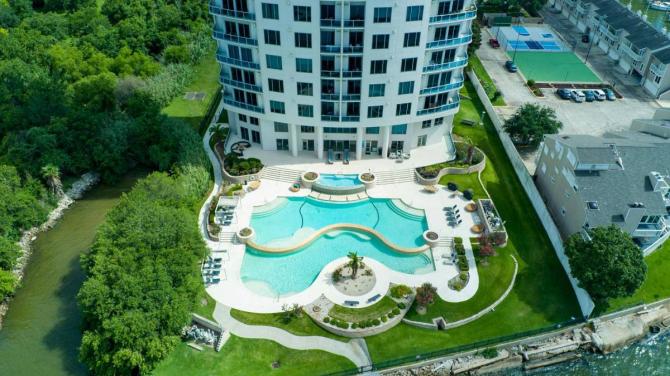Interest in green living is rising, with clean air and open spaces becoming key selling points for residential projects, particularly as Indian cities struggle with deteriorating air quality.

Kindly note the image has been posted only for representational purposes. Photograph: Kind courtesy Drones Flown/Pexels.com
Rising air pollution in Delhi, Mumbai, and other metros is making clean air and good air quality non-negotiable for homebuyers.
Developers are responding by integrating green living features, including guaranteed air quality index (AQI) levels, into their projects.
These initiatives are typically seen in the luxury and ultra-luxury segments, where prices can be 25 to 40 per cent higher than standard projects — yet buyers are willing to pay the premium.
“Developers will charge extra if they assure AQI.
“When air pollution remains high most of the year and spikes in winter — especially in places like Delhi, shrouded in smog — clean air becomes a basic need,” said a senior executive at a National Capital Region-based real estate services provider.
Some developers, such as DLF and Pioneer Urban, are creating spaces that actively maintain AQI levels.
DLF Homes, for instance, is building a nearly 390,000 square feet AQI-and temperature-controlled recreational area for residents in its upcoming ultra-luxury project, Dahlias, in Gurugram.
“We’re ensuring air quality inside our Advait Senior Living project in Gurugram remains healthy.
“Outdoors, green areas cover a large proportion of the project, and there is no vehicular traffic at ground level.
“Indoors, an ultra-filtration system using apartment-wise treated fresh air units cleans incoming air to give it a fresh feel, rather than recycled air-conditioning,” said Rakesh Bohra, chief operating officer at Pioneer Urban Land and Infrastructure.
With rising demand for sustainable living, developers are factoring green features into pricing strategies.
Ravi Saund, founding director of NCR-based Emperium, said homebuyers are now highly conscious of their living environment and actively seek projects prioritising health and well-being.
“In high-pollution cities, projects with advanced air purification systems, dedicated green zones, and wellness amenities often carry a premium of 10-20 per cent over standard projects,” he said.
Snehdeep Aggarwal, chairman of Bengaluru-based Bhartiya Group, added that buyers are willing to pay higher premiums for properties with proven green credentials.
“We see this as a fair reflection of long-term benefits, such as lower healthcare costs, better quality of life, and higher resale value,” he said.
Developers note that green-focused projects generally fall in the premium to luxury range, typically upwards of Rs 2.5 crore because of higher investments in land, sustainable design, and maintenance of green spaces.
Sriram Mahadevan, chief executive officer of Shapoorji Pallonji Real Estate and managing director of Joyville Shapoorji Housing, said that no single feature determines a project’s premium value — rather, it is the combination of multiple elements.
“For buyers, it’s an investment in quality of life, and they are willing to spend more considering the long-term benefits such projects offer,” he said.
Interest in green living is rising, with clean air and open spaces becoming key selling points for residential projects, particularly as Indian cities struggle with deteriorating air quality.
Several realty firms report increased buyer traction for green living projects across Tier-I metros, a trend expected to continue.
Earlier this year, BPTP Group announced Rs 1,500 crore in inventory bookings on the first day of its Gurugram-based luxury green living project, Amstoria Verti-Greens.
The project features bespoke residences with sky gardens connecting various towers.
Similarly, developers such as Signature Global, Shapoorji Pallonji, and Bhartiya Group are rolling out projects with sustainable, eco-friendly infrastructure.
A spokesperson for Mahindra Lifespace Developers said all their projects are Indian Green Building Council-certified, which includes indoor air quality standards.
“We use low-volatile organic compound paints to minimise indoor air pollutants and grow native plant species to generate more oxygen around the property,” they added.
Santhosh Kumar, vice-chairman at property consulting firm Anarock, cautioned that green homes alone don’t guarantee clean air.
“Achieving this requires additional features related to location, distance from pollution sources, green open spaces, and lung space within the project,” he said.
Experts observe that growing awareness of air quality is driving buyer interest, especially among families, senior citizens, and non-resident Indians seeking pollution-free, serene environments.
Pradeep Aggarwal, founder and chairperson of Signature Global India, said the company’s majority of green projects are either gold-rated by IGBC or Excellence in Design for Greater Efficiencies-certified, a global International Finance Corporation certification.
“These certifications ensure optimal use of natural resources, strong energy efficiency, reduced carbon footprint, and future-ready spaces prioritising well-being,” he said.
New realty
- Buyers willing to pay 25% to 40% premium for clean air and green spaces
- DLF and Pioneer Urban offer projects with controlled AQI zones in Gurugram
- Pioneer Urban uses ultra-filtration systems and traffic-free layouts for better air
- Emperium group says health-focused projects command 10% to 20% higher price
- Experts say clean air depends on location and not just design
Feature Presentation: Ashish Narsale/Rediff




